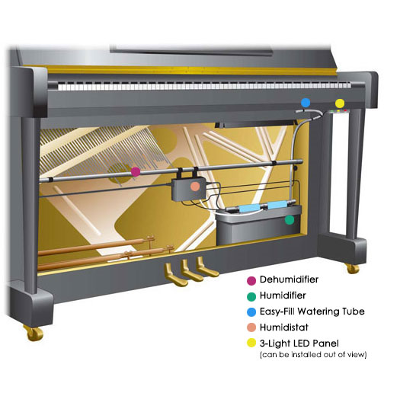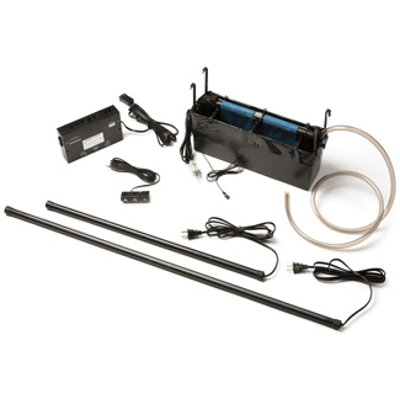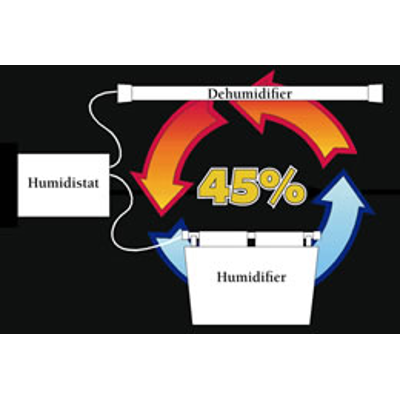Shipping Quote
Product Inquiry
Make an Offer
Trade & Save
Financing Quote
Home / Shop / Pianos / Climate Control Systems
Piano Life Saver System Upright Piano Humidity Control
- Description
- Customer Reviews (0)
Piano Life Saver System Upright Piano Humidity Control
The Piano Life Saver System is completely silent and installed on the underside of your piano.
System Components:
• Dehumidifier: When the Humidistat senses the humidity level is too high, the Dehumidifier carries away moisture on warm air currents until the Humidistat senses that the humidity level is within range.
• Humidifier: When the ambient humidity is too low, the Humidifier adds moisture to the air inside the piano until the Humidistat senses that the humidity level is within range.
• Watering Tube: When the yellow light blinks, the water tube permits you to easily add water to the System.
• Humidistat: This is the brain of the System. It senses whether the micro-climate within your piano is optimal and automatically switches the System to function as a Dehumidifier or Humidifier to protect your piano from damage caused by changes in humidity.
• 3-Light LED Panel: The panel features a green light marked POWER to indicate the System has electrical power and a yellow light marked WATER which blinks when the Humidifier needs water. If the System includes the optional Smart Bracket on the Humidifier tank, the red light marked PADS will blink when the pads are no longer wicking water, indicating they should be replaced.
WHY DO I NEED A PIANO LIFE SAVER?
Your piano was a large investment. As an integral part of a regular maintenance routine by your piano technician, the Piano Life Saver System will help you protect it and ensure many years of trouble free playing and beautiful music. The Piano Life Saver System is a highly engineered, very low maintenance, humidity control system that fits right into your piano. It is designed to stabilize the moisture content of the wood in your piano ensuring pitch stability and increased longevity.
Pianos are largely made up of wood, felt, and metal. Extreme levels of humidity, high or low, or a fluctuating humidity level, will have detrimental effects on all of these materials both in the short and long term. Many manufacturers describe this as “abusive” in the wording of their warranties.
When humidity levels rise, wooden components absorb moisture from the air and will actually swell to the point that they are measurably larger. Of course, when the humidity level decreases, they will shrink. Have you ever noticed how the doors in your home stick during one time of year and during another the gaps between boards on your hardwood floors open up? Imagine this happening inside your piano. When your piano is repeatedly subjected to these cycles, the glue joints holding all of these pieces together can start to fail and major components like the soundboard can crack.
The piano will also be unstable in pitch. All pianos go out of tune and need to be tuned regularly. However, it is not possible to put a “fine tuning” on a piano that has strayed far from pitch. If the pitch varies and the technician needs to make a significant adjustment to it, several things will happen. First, and most instantly noticeable, will be an additional charge by your technician. Because he/she must do more work, they will have to charge you more. Secondly, the piano will incur more wear and tear and stress the farther it is from pitch every time it is tuned. And finally, the stability of the tuning will be reduced.
The hammers which strike the strings, initiating the sound, are made of felt. Felt is compressed wool fibers. We’ve all heard people complain how they’re “having a bad hair day” due to high or low humidity. The wool fibers are no different. They will swell and shrink too. This can result in a lack of consistency in the tone of your piano.
The strings in your piano are made of steel, with the bass having a copper winding. If the humidity is too high, these will eventually rust, leading to expensive repairs.
The Piano Life Saver System is designed to protect your piano from these problems and is therefore an integral part of proper piano care and maintenance. We have yet to find a location anywhere on earth that does not benefit from this System.
HOW IT WORKS
Piano technicians, retailers, rebuilders, component makers, and major piano manufacturers recommend installing the Piano Life Saver System as an important step in proper piano care and maintenance. The Piano Life Saver System continuously monitors the humidity level of the air inside your piano using a sophisticated electronic Humidistat which is located very close to the soundboard.
When the Humidistat senses that the humidity level is too low, it activates the Humidifier. When it senses that the level is too high, it activates the Dehumidifier. This shallow cycle continues day after day, year after year, protecting your piano from external conditions.
Please note that installation of the Piano Life Saver System is not intended to supplant regular tuning and maintenance by your piano technician. It is designed to increase the serviceable life of your instrument and keep it playing and sounding its best between regular service intervals. Think of it like you would brushing your teeth daily. You still need to see the dentist on a regular basis.
Protect your investment by having the Piano Life Saver System installed inside your piano. Professional installation is required for warranty coverage.
BENEFITS OF KEEPING HUMIDITY REGULATED IN A PIANO
Your piano is primarily made of wood. Like the living trees that produced the wood used in the building of your piano, wood responds to climate and environment – it breathes, stretches and flexes. All wood instrument musicians are familiar with the effects of changing humidity levels. Guitarists must frequently adjust their bridge heights and fingerboard action. Violinists must pay close attention to maintaining constant, ideal humidity levels – or else they may find their violin rather dramatically springing apart during a performance!
Just as with other wood-based instruments, your piano needs a constant level of ideal humidity – between 40% and 50% – to maintain its pitch and tone, quality of action, and to prevent permanent damage.
Maintaining Pitch and Tone – moist conditions
The soundboard is the single largest piece of wood in your piano. It is the speaker of the piano. In order for the piano to have proper tone, the strings, bridge, and soundboard must be in tension together. To make this occur, the piano is designed and built so that the strings have a slight downward angle on both sides of the bridge. This is called downbearing. Along with this, the soundboard must have a slight upward curve which is called crown. The downbearing and crown must be very precise. It takes very little change to dramatically compromise the tone.
When the humidity drops, the soundboard shrinks and flattens, lowering the tension of the strings. The pitch will drop or become flat. The technician will have to perform a pitch raise to bring the piano back to the proper pitch before a fine tuning can be done. When the humidity rises, the soundboard absorbs moisture from the air, making it swell and increasing the crown. Now, the pitch will go up or become sharp.
This chart demonstrates how drastically pitch can change when your piano is exposed to fluctuations in the humidity during seasonal weather changes.
The Piano Life Saver constantly regulates the humidity level inside the piano so that these variations can’t occur. When the technician arrives for your regularly scheduled tuning, he/she is quickly and easily able to perform a fine tuning and leave your piano sounding its absolute best.
Maintain Quality of Action
The complex mechanical linkage that starts with the key that you press with your fingers, and ends with the hammer striking the strings is called the action. It quite literally has thousands of wooden parts that must all be precisely adjusted to work perfectly together. This adjustment process is called regulation. When the humidity changes, the precision is lost, resulting in the touch you have grown accustomed to changing and becoming inconsistent. Primarily in a vertical piano, the Piano Life Saver System will help counteract these issues.
Prevent Sluggish or Sticking Keys – piano keyboard
Just as doors and drawers become tight and difficult to move, the keys of your piano may respond slowly or even stick down in times of high humidity.
Stop Rattling Keys and Noisy Action in Low Humidity – Piano action diagram
Just as doors and drawers become loose in dry air, the keys of your piano may rattle or become mechanically noisy. When the wooden action parts shrink from dryness, they become loose and can move around. This will lead to premature wear of these parts and costly repairs in the future.
Prevent Costly, Permanent Bridge and Soundboard Damage – cracked soundboard
Over time, constant changes in humidity levels, with the corresponding shrinking and swelling of the soundboard, will damage the integrity of the soundboard. You will see this damage in the form of pressure ridges and cracks in the board. A crack in your soundboard has an extremely negative affect on the value of your piano. By maintaining a constant level of humidity in your piano, the Piano Life Saver System virtually eliminates these damaging humidity level swings and protects your instrument.
Prevent Pinblock Damage – moist pin conditions
Piano strings are under tremendous tension. The strings are coiled around tuning pins that are driven into holes in a multilayered piece of wood, usually maple, called the pinblock. The tuning pin is actually slightly larger than the hole that it is driven into. The resulting tight fit is necessary for the piano to be tuneable.
When the humidity increases, swelling the wood, the tuning pins may become so tight that the technician has trouble making the delicate adjustments that are necessary in a fine tuning. When the humidity level drops, the pinblock will shrink, resulting in loose tuning pins. This can result in a piano that will not hold tune very long or even render it completely untuneable. At this point you must either replace the pinblock or the piano.
The up and down cycling of humidity can also cause the layers in the pinblock to delaminate. This is virtually always accompanied by cracks developing within the layers themselves. The cost of this type of repair can often exceed the value of the piano.
Once again, the Piano Life Saver System keeps a constant moisture content in the wooden parts of the piano, ensuring ease of tuning, stability, and a long life for the pinblock in your vertical piano.
Prevent Serious Rust Damage to Strings and Pins
The strings of your piano are responsible for producing the musical sounds. With exposure to high humidity levels over long periods, strings become rusted and corroded.
Rusted pins
At the junction where rusted strings wrap around rusted pins, rust corrosion forms a hardened bond between the two. Then, during a tuning, when your piano technician turns the pins to stretch the strings, the inflexible, rusted string snaps at this joint.
Because the Piano Life Saver System maintains a safe level of humidity in your piano, rust is much less likely to form on your strings. Remember, never clean your strings with a damp cloth!
…………………………………………….PORTABLE “ROOM” EQUIPMENT…………………………………………………………PIANO LIFE SAVER SYSTEM………………….
Electricity Used in 24 Hours…………………………..5.280 kWh*………………………………………0.864 kWh (Grand System) 0.564 kWh (Vertical System)
Noise Level and Appearance…………………………Noisy, Intrusive, Unattractive, Messy……………………………………………………….Silent, Discreet, Clean
Piano Owner Water Responsibility………………..Must empty or fill reservoir at least once every day……….Fill reservoir twice a month on average.
Monitoring of Humidity………………………………….Requires daily monitoring with a Hygrometer…………………………..Automatically monitors humidity
Mold Growth and Home Structural Damage….In cold weather, room humidifiers can drive moisture……………………Will not cause mold growth
……………………………………………………………………….into walls, causing mold growth & structural damage……….or structural damage to your home.
*Portable Room Equipment usage based on manufacturer’s published specifications. We selected the most economical of the commonly used models to come up with this number. Many were much higher.
PIANO LIFE SAVER VS WHOLE HOME AND PORTABLE SYSTEMS
Whole-House Air Conditioner
While it is well known that most forms of air conditioning dehumidify the air as they cool it, air conditioners are designed to cycle on and off to maintain a desirable temperature. When the desired temperature is achieved, the unit turns off, no matter what the humidity level is. In addition, most whole-house air conditioners are unable to reduce the relative humidity lower than 60%, which is outside the safe zone for pianos.
Whole-House Humidifier
Most whole house humidifiers have the same limitations as air conditioners. Since they are mounted on the furnace, when the furnace has achieved the desired temperature, both the furnace and the humidifier turn off, no matter what humidity level is attained in individual rooms. They also can use over 10 gallons of water per day. The Piano Life Saver System uses 2-3 gallons per month.
Portable “Room” Humidifiers and Dehumidifiers
The Piano Life Saver not only saves you money, time, and hassle, it outperforms a room humidifier/dehumidifier:
The initial cost of a portable dehumidifier and humidifier is about the same as a Piano Life Saver System. However, when it comes to day-to-day maintenance, if you place any value on your time, you will pay much more to keep a dehumidifier and humidifier operating continuously.
With the use of a portable dehumidifier and humidifier, you will need to monitor the environment daily with a hygrometer to be sure the humidity remains in a safe range for the piano. The Piano Life Saver System automatically keeps the humidity in a safe range for your piano year after year.
To operate a portable dehumidifier or humidifier continuously requires that you empty (or fill) a large reservoir at least once every day. Who will do it for you when you’re not at home? In contrast, the Piano Life Saver System’s small Humidifier requires only one can of water, twice a month, in most environments.
Portable dehumidifiers and humidifiers are intrusive, noisy appliances while the Piano Life Saver System is discreetly located inside the piano and works silently.
The electricity cost to operate the Piano Life Saver System is a small fraction of the cost to operate a portable humidifier/dehumidifier.
The average room humidifier will use several gallons of water per day, whereas the Piano Life Saver System uses only 2-3 gallons per month on average.
In cold northern climates, keeping the entire room in the safe humidity zone for pianos results in condensation on windows which may lead to structural damage around the window. Condensation may also form inside the walls surrounding the room and promote the growth of mold and mildew and can cause structural damage to both interior and exterior walls. Since the Piano Life Saver System only humidifies the piano, no damage to your home will take place.



